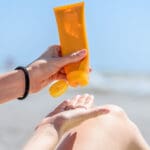We all know that plastic waste is a threat to the environment, but did you know that when disposed in the environment plastic waste breaks down to smaller particles? Even smaller than 1 micrometer. These so-called nanoplastics are very hard to detect. Understanding the effects of nanoplastics on the environment starts with the ability to detect them! In their study researchers at Universiteit Utrecht use photo-induced force microscopy. For example they found that the nanoplastic surface degrades faster in salt water than in sweet water.
Understanding the smallest matter is essential in the next steps towards a solution!
More information and the publication can be found on the website of ARC CBBC.




